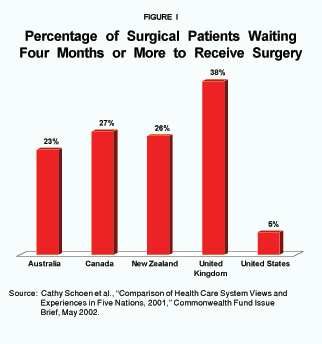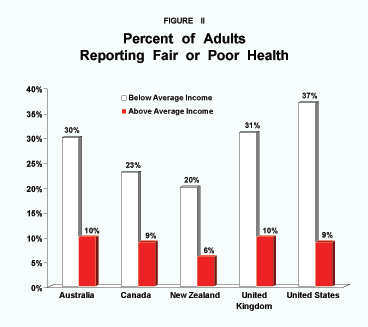A new survey sheds light on the relative merits of the health care systems in five English-speaking countries. This is the latest in a series of studies conducted by researchers at the Harvard School of Public Health and the Commonwealth Fund in New York City.
The authors surveyed 1,400 adults each in the United Kingdom (U.K.), Australia, New Zealand, Canada and the United States on the merits of their health care systems as well as their personal experiences.
Insuring for Health Care.
Each country has a different system of financing health care. The U.K. has a National Health Service in which physicians are on the government payroll and hospitals are owned by the government. Canada uses private-practice physicians and nonprofit hospitals, but provincial governments act as the sole payer for virtually all essential health care, except dental services and prescription drugs. The United States has government programs for the poor and the elderly and voluntary private insurance for the rest of the population. New Zealand's system is similar to that of Britain but with a larger private sector. The Australian system is a hybrid, a national system supplemented with private financing.
The scope of coverage varies, but in general all five systems have incomplete or no coverage for prescription drugs, dental services or nursing home care. Similarly, vision care, cosmetic services and alternative medical services usually are not covered.
It is widely believed that each of these countries, other than the United States, has universal health care coverage, but that is not really true. People fall through the cracks in the safety net systems and no system can provide every individual with every possible health care service.
Paying for Care.
On every measurement, people in the U.K. have the least direct cost. Only 3 percent of Britons say they have had "problems paying medical bills," compared to 7 percent in Canada, 11 percent in Australia, 12 percent in New Zealand and 21 percent in the United States. Forty-three percent of Britons report no out-of-pocket costs in the previous year, and only 2 percent report having paid more than $1,000. The figures for the United States are 7 percent and 26 percent respectively.
Lower-income Americans have trouble affording care in greater numbers than their counterparts in other countries. Thirty-nine percent of lower-income Americans did not fill a prescription due to the out-of-pocket cost in the past year. This compares to 21 percent in Australia, 22 percent in Canada, 20 percent in New Zealand and 7 percent in the U.K. Fewer people with higher incomes chose not to purchase a drug because of the cost, but the numbers are far from negligible: 18 percent in the U.S., 18 percent in Australia, 7 percent in Canada, 11 percent in New Zealand and 7 percent in the U.K.
Rationing by Waiting.
Health care access is defined as the ability to obtain a needed medical service. The study finds that, Americans have much shorter waiting times to receive hospital services than do people in other countries. Only 5 percent of U.S. patients report waiting four or more months to receive surgery. This compares to 23 percent in Australia, 27 percent in Canada, 26 percent in New Zealand and 38 percent in the U.K. [See Figure I.] Australia and New Zealand rank highest on being able to see a doctor on the same day – 62 percent and 69 percent respectively. Only 36 percent of U.S. residents, 42 percent of Britons and 35 percent of Canadians can see a doctor on the same day.
Unequal Health Outcomes.
The way we pay for health care seems to make only a marginal difference in health status. All five countries report that lower-income people have much worse health than do those with higher incomes, usually by a factor of three. [See Figure II.] Since the study will be used to discuss the merits of national health insurance, note that the lower-income results in Figure II include a disproportionate number of elderly – the one U.S. population group that has universal health insurance.
Satisfaction.
The survey revealed enormous dissatisfaction with health care services in all five countries, although the U.K. is the only country in which people are less satisfied with their health care system than they were four years ago. In all five countries, about 80 percent of the population said that their system needs to be "completely rebuilt" or "fundamentally changed." The number favoring "only minor changes" is 25 percent in Australia, 21 percent in Canada, 18 percent in New Zealand, 21 percent in the UK and 18 percent in the US.
Conclusions.
Apparently none of the five countries surveyed has found an ideal health care system. Each country has its own strengths and weaknesses. The United Kingdom has the least out-of-pocket costs, but it has the longest waiting times. The United States is just the opposite. The rest fall somewhere in between on both measures.
But to argue that the U.K. or Canada has a superior system, one would have to place a very high value on health care being "free" at the time of service and a low value on getting care quickly.
Despite superficial differences, all five systems rely almost exclusively on third-party payment, either public or private. Even in the United States, people pay directly for only 15 percent of all health care costs. Employers, insurance companies and/or the government pays the other 85 percent. The proportion of direct payment in the United States has fallen precipitously over the years. In 1980 patients paid 28 percent of all costs, down from 56 percent in 1960.
All five countries keep people from getting the care they believe they need – rationing care through prices, waiting lists, limiting the supply of services, controlling the number of doctors or simply denying care.
No wonder the level of discontent is so similar in all five countries!
Greg Scandlen is a senior fellow in health policy with the National Center for Policy Analysis.